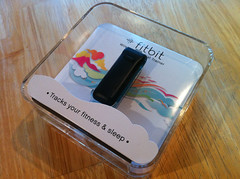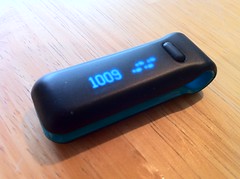The Fitbit, as far as I can tell, is a perfect device. What is a Fitbit? Fitbit is a device and a website that you can use to track your physical activity. Yes, at first glance, the Fitbit is essentially an electronic pedometer, but it is actually a lot more.
 Firstly, let me say that the Fitbit packaging design rivals anything Apple produces – it’s pretty. The box is small and contains a lot. You get the Fitbit device itself, the charging/syncing stand, a belt clip, and a wrist strap. To start, you install some software on your PC and plug the stand into a USB port. Registering the Fitbit device to your computer is simple. You set the device on the stand, press the button, and type the code that appears into the software on the PC. This simplistic setup is very much appreciated in the age of complicated devices. The Fitbit just works.
Firstly, let me say that the Fitbit packaging design rivals anything Apple produces – it’s pretty. The box is small and contains a lot. You get the Fitbit device itself, the charging/syncing stand, a belt clip, and a wrist strap. To start, you install some software on your PC and plug the stand into a USB port. Registering the Fitbit device to your computer is simple. You set the device on the stand, press the button, and type the code that appears into the software on the PC. This simplistic setup is very much appreciated in the age of complicated devices. The Fitbit just works.
The Fitbit device will then work essentially like a regular pedometer, recording how many steps you take continuously. Unlike your standard pedometer though, it uses accelerometers - like those used to detect motion in a Wii controller - to detect steps with surprising accuracy and no moving parts. From there, everything about this device is different.
In spite of the use of the sync stand, this device is completely wireless. While I write this post, seated in my desk chair in front of the PC, the Fitbit is sending my step data to its charging base wirelessly. There is no need to put the Fitbit on the stand to sync the data. Every so often, the Fitbit needs charged. To do so, I place it on the stand, where it uses the USB power to recharge its battery. That’s it. How long does the battery last? To be honest, I can’t say – I forget how long it lasts between charges because it lasts so long. I would say a charge can last two weeks easily.
 The Fitbit has only one button. During the day, you can press this button to see how many steps you’ve taken. The device uses a relatively bright, blue OLED screen to show you its data. You’ll see the number of steps taken after the display of the word “Steps” with some little footprints. If you press the button again while the screen is on, the Fitbit will cycle through multiple readouts, including calories burned, miles traveled, and a graphic flower that grows based on your walking/running performance for the day. The values that are stored recycle each day at local midnight, so what you see on the screen is only today’s scores.
The Fitbit has only one button. During the day, you can press this button to see how many steps you’ve taken. The device uses a relatively bright, blue OLED screen to show you its data. You’ll see the number of steps taken after the display of the word “Steps” with some little footprints. If you press the button again while the screen is on, the Fitbit will cycle through multiple readouts, including calories burned, miles traveled, and a graphic flower that grows based on your walking/running performance for the day. The values that are stored recycle each day at local midnight, so what you see on the screen is only today’s scores.
If you are away from the base station for more than a day, that’s ok. The Fitbit will store several days of information internally, then sync them when you come back in range of the base station. Note that the Fitbit does not store only the day’s totals, but also your activity within at least 5-minute increments for all of the days that it hasn’t yet sync’ed. This was great when I went on a business trip, used the Fitbit while I was exploring the host city, and was able to record my walking activities effortlessly over the air as I walked in my front door.
Another feature of the Fitbit device allows you to hold in its button to record the start of an activity. So if you start a run, you hold in the button until the screen flashes with the “Start” flag, and then you run. When you finish your run, you hold the button in again to end the activity. All activities marked this way are separated out when you sync the data to the Fitbit website.
When the data syncs, it is uploaded to the Fitbit website. There, you can see your daily activities, broken down by light, moderate, or heavy activity level. It’ll show you your activity for the day as an aggregate over the last 30 days, and will show you detailed information about steps, calories burned, and distance down to 5-minute granularity.
 The website allows you to view and categorize your marked activities, as well as enter custom activities into the log, such as weight training or other fitness activities. The log includes a significant number of useful additional data points, including food calorie tracking (with an easy-to-use food lookup database), heart rate log, glucose level log, blood pressure log, weight log, and sleep log.
The website allows you to view and categorize your marked activities, as well as enter custom activities into the log, such as weight training or other fitness activities. The log includes a significant number of useful additional data points, including food calorie tracking (with an easy-to-use food lookup database), heart rate log, glucose level log, blood pressure log, weight log, and sleep log.
The sleep log is interesting because the Fitbit device is designed to integrate with this in a unique way. Using the included wristband, you wear the Fitbit on your non-dominant wrist as you go to bed. If you press and hold the activity start button before you fall asleep, the Fitbit will track not only when you actually fall asleep (using a process known as actigraphy, but will track how well you sleep through the night. In the morning, hold the activity button to mark when you wake up, and the site log will automatically trim the ends off for when you actually fell asleep and woke up, and record this as your sleep time.
There are a ton of other great features with the website and the device. One of my favorites is the integration of the Withings scale, which is a scale that wirelessly tracks and logs your weight and BMI to their website. There is also a mobile version of the website that exposes most of the features of the main site, for when you want to track activities while on the go. Premium features on the web site (these cost about $50 per year, while everything else I’ve mentioned so far is free after buying the device) include in-depth analysis of your logs and recommendations for keeping fit.
As I said, the Fitbit is just about flawless. I put mine through the washer once (which is explicitly recommended against), and it survivied. The second time, it made it through the dryer too, and it seems the water and heat finally killed it. I immediately replaced it with a new one; it’s that good of a gadget.
The only things I could think to improve the Fitbit would be if it was slightly more resistant to accidental laundering, and if there was more integration. The integration feature with the Withings scale is fantastic, but it only makes me crave more, like integration with GPS (like the Garmin Forerunner) or heart rate monitors/loggers, and iPhone apps and websites like RunKeeper or Digifit.
While I have little UI quibbles with their website, and I’d love to see expansion in their integration capabilities, for the price of the device ($89 from Amazon - $10 off - if you use my affiliate link) and what a great and successful job it already does, I can completely overlook these things.
I’d say that the Fitbit is one of the best gadget purchases I’ve ever made, and its utility in pointing out the utter inadequacy in my daily physical activity is invaluable for getting me on the right fitness track.